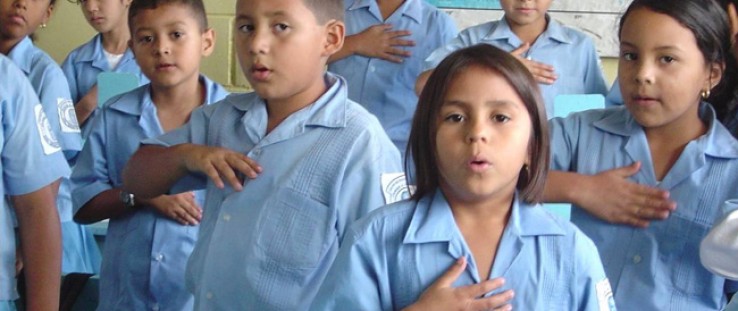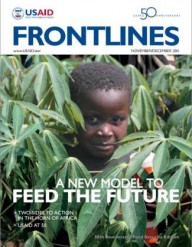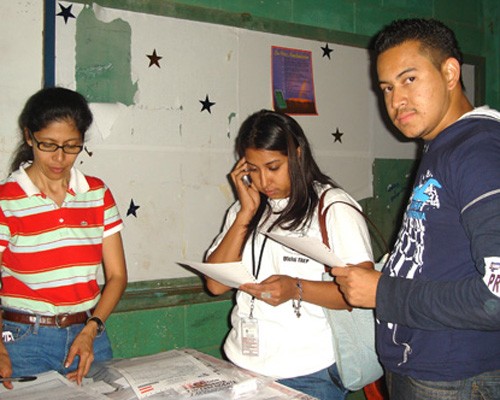 Children involved in a USAID democracy program sing the Honduras national anthem. The Agency has supported democracy programs in Honduras for five decades.
CREDIT: USAID
Children involved in a USAID democracy program sing the Honduras national anthem. The Agency has supported democracy programs in Honduras for five decades.
CREDIT: USAID
 Children involved in a USAID democracy program sing the Honduras national anthem. The Agency has supported democracy programs in Honduras for five decades.
CREDIT: USAID
Children involved in a USAID democracy program sing the Honduras national anthem. The Agency has supported democracy programs in Honduras for five decades.
CREDIT: USAID
Nineteen eighty-five was an important year for democracy in Central America. The Marxist Sandinista revolution had taken control in Nicaragua and the United States was determined that neighboring countries would not follow suit. To promote its priorities in the area, the United States launched a program of military and development assistance in Central America, including the establishment of modern democratic processes and institutions.
Honduras was a keystone of this strategy. It had a tortured history of coups and dictatorships, exacerbated by its position as a banana republic that had often been manipulated by foreign economic and political interests. Honduras’ long border with Nicaragua invited cross-border subversion, even possible invasion. Poverty and a disaffected population created the conditions for revolution.
Honduras at the time was governed by President Roberto Suazo Córdova, whose regime was characterized by incompetence and corruption. Hondurans were pretty much resigned to the likelihood that Suazo or a surrogate would be perpetuated in power through a fraudulent electoral process of some kind. There was no tradition of transparent elections, and cynicism ran deep. A rigged election would discredit democracy and set back U.S. objectives in Central America.
The U.S. Government therefore decided to take the risk of becoming directly involved in the upcoming Honduran presidential election, hoping that an honest election would make the citizens feel empowered and install a government committed to social and economic development. The United States and its style of representative democracy would gain credibility in Honduras and throughout Central America, and other important development and security priorities would be advanced.
U.S. Ambassador John Ferch and USAID/Honduras Mission Director Anthony Cauterucci decided that USAID should take the lead in the effort to assure the efficiency and transparency of the election. They approached the National Election Tribunal (TNE) and agreed that USAID would provide ballot paper, clear plastic ballot boxes, ink, printing services, a signature machine for the ballots, and election observers. To implement this high-profile, politically critical assistance, Cauterucci chose Bob Murphy, who was a contractor working on a special USAID initiative in the eastern region of Honduras.
Bob was a trusted USAID veteran, a good Spanish-speaker, and knew how to make things happen. What he was not was an expert on international donor support for elections; his electoral experience amounted to voting. He immediately went to work researching requirements and initiating procurements.
A signature machine was urgently needed to put the TNE official signature on every ballot, as required by the Honduran Constitution. Bob located a machine that met the technical and legal requirements, placed the order, and traveled to Miami to pick it up. The machine was there waiting for him, but the supplier insisted on payment paperwork that USAID/Honduras had not provided. After several fruitless phone calls, Bob finally bought the signature machine himself. He charged it to his American Express card, carried it back to Honduras on the plane, and settled up later with the USAID comptroller. Disaster was averted and the TNE went to work producing the ballots with the required signatures.
But another disaster was just around the bend. Long-lasting ink had to be at every electoral table; voters were required to dip a fingertip into the ink, leaving a long-lasting stain and making it impossible for dishonest voters to attempt to vote repeatedly at multiple polling stations on Election Day. After much research and consultation, Bob found that the recommended ink formulation contained silver nitrate, a chemical used in photographic paper that turns black when exposed to light. It deeply stains the skin and is difficult to wash off. Bob ordered 8,000 bottles—two for each of the 4,000 electoral tables throughout the country.
When the shipment of ink arrived, there was no place to store it. Normal commercial storage sites and the Government of Honduras—including the TNE itself—wanted nothing to do with it. They feared that it would be tampered with as part of the expected electoral fraud, and that those responsible for storage could be implicated. Nobody would take the ink. In the end, the 8,000 bottles wound up in Bob’s house in Tegucigalpa. One day, he decided to have a look at the ink and opened one of the boxes stacked in his house. He got two big surprises.
Election Poison
First, he was shocked to find that all 8,000 ink bottles were labeled with a skull and crossbones, indicating that they were poison. Upon investigating, he was told by the supplier that the silver nitrate in the ink, if ingested (as opposed to having ones finger dipped in it), was potentially carcinogenic.
Obviously, the consequences of this label were potentially disastrous. Voters would see it and be afraid to vote; rumors would quickly spread that the government had supplied poisonous ink to scare off voters. When word got out that the United States had supplied the ink, the reaction would be even worse. The election would almost certainly fail and the image of the United States would go down with it.
In an effort to salvage the situation, Bob organized an emergency label-changing operation. A few friends along with their spouses and kids agreed to help. An assembly line was formed one Saturday morning on the patio of Bob’s house. Ink bottles were removed from their boxes and placed into boiling water to soak for a few minutes; the bottles were removed and the offensive labels peeled off; the bottles were dried, new labels reading “indelible ink” were attached, and they were re-packed in their boxes.
After many hours of hard work, all 8,000 bottles had been re-labeled. Some ink had leaked into the water used to soak off the poison labels, and everyone went home with their hands and arms blackened by election ink that didn’t disappear for days. Another potential calamity had been averted.
Transparent as Water
The second surprise was that the ink looked clear, colorless, and transparent—just like clean water. When asked, the ink supplier explained that the silver nitrate changes quickly to black when exposed to light and that no other colored pigment is needed. Not so in Honduras. Voters’ suspicions of fraud would cause them to assume the worst—that water had been substituted for the ink. Clear, ineffective ink could make it easy for dishonest voters to vote repeatedly and throw the election.
Crisis meetings ensued at the embassy, the USAID mission, and the TNE. The ink was tested repeatedly to determine how quickly and completely it blackened when touched by skin and exposed to light. After much debate, the TNE decided that the ink would work and should be used, but that voters should not know in advance about its lack of color. If people knew what the ink contained, the TNE feared, someone with knowledge of chemistry would figure out that it could be removed using bleach.
Over the next few weeks, election materials were distributed to thousands of voting sites throughout the country, energetic campaigning took place by political parties, election workers were trained, and voter registration and education took place. Everything seemed to be going smoothly, in spite of lingering concern that somehow, somewhere, electoral fraud might take place.
In the final lead-up to Election Day, the mood of the country turned festive, almost euphoric; it appeared that a clean election was finally going to take place in Honduras and Hondurans were going to freely choose the good government they wanted. It felt historic, and it felt good.
USAID staff members traveled with international observers to view the voting throughout the country. One of them, Dick Martin, a USAID/Honduras education officer, helicoptered to a remote city with a contingent of U.S. congressional staffers. The polling places were scheduled to open at 6 a.m. Community officials proudly received and escorted the observer team past long lines of cheerfully expectant voters.
However, 6 a.m. didn’t dawn the way it should have; the sun had yet to rise, and the morning was cloudy and dark. Furthermore, the polling place was in a school that was not electrified and had no lights. At the appointed hour, the doors opened and the first voters entered. In the near darkness of the schoolrooms, the work of checking voting lists, confirming ID credentials, and voting was difficult. But worst of all, without light, the USAID ink on voters’ fingers didn’t change color. By 6:15, dismayed local officials closed the polling stations and announced that water had been substituted for the ink, invalidating the election. This scene was repeated simultaneously in thousands of places across Honduras.
Moments later, the head of the TNE came on the national radio network and announced that the ink was a chemical that took a couple of minutes to change color. At the same time, God smiled on Honduras, the sun came out, and the voters’ fingers turned black. The sense of relief was palpable and spread almost instantaneously by radio to the whole country. Polling places everywhere re-opened and the election was a success. By the end of the day, the electoral process and the TNE were praised by the observer teams for being efficient and transparent.
Twenty-five years later, in 2010, Honduras experienced another chaotic and non-democratic change of government. Obviously, creating democracy is not quick or easy. USAID’s successful—if white-knuckled—support for Honduras’ 1985 election didn’t miraculously transform the country’s history of troubled and weak democratic institutions, but it undoubtedly made an important short-term contribution to U.S. foreign policy objectives in Central America at the time.
It demonstrated once and for all that elections in Honduras can be credible, fair, and transparent if the conditions are right. Hard work, risk-taking, commitment, a sense of humor, and teamwork—characteristics of USAID missions throughout the world—clearly saved the day in Honduras.










Comment
Make a general inquiry or suggest an improvement.